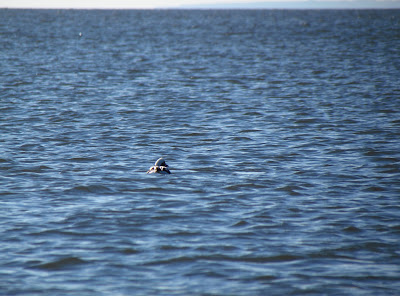The day comes calm with a hazy sun and I head down the coast hoping that the prediction of south winds, if any, will push me home. With such calm waters, I cut the bay directly between Pond and Merwin Points and, the calmness holding, I head straight from there out to Charles Island, cleaving a flock of some 500 gulls and four great scaups as I go. The gulls are picking something small from the surface, and collecting a lost feather, I find a couple of tiny shrimp like crustaceans clinging to it, no doubt what they are eating.
From some distance, I spot three people hiking counter-clockwise around the island. They have a schedule to keep and will be gone by the time I arrive. The island is connected by a bar that is passable for a brief time at low tide. At this tide level, it provides them access and keeps me from circling the island.
 |
| Charles Island |
I edge along the shallows of the island spotting a solitary egret high in one of the trees. A duck flies directly at me, but unlike any duck that I've seen, it does not veer away as it approaches, but instead, passes by just 15 feet away, turning its head to look at me as it goes. It is not a duck, but an oyster catcher.
I pull the canoe up in the round rocks of the shallows on the seaward side of the island and take a short walk along the bank where stonework ruins from the former Jesuit retreat tumble in large conglomerates as the bank erodes. The trees and undergrowth are notably shaggy - the result of storms sweeping this unprotected spot. It reminds me of a tornado damaged landscape...stuff just tossed about. The island was once the sight of a 19th century hotel, that seemed to become a sleezy party house in the early 20th century. Then, the Jesuits came, for awhile. Now, Charles Island is nesting grounds for a couple hundred egrets and herons, one of the northeast's best rookeries. It will be off limits in a few weeks to people, but now, there is just that one egret and a couple dozen Canada geese and crows.
 |
| Jesuit ruins |
I detour over to the mouth of the harbor and let the flooding tide sweep me into Gulf Pond. I just go in a hundred yards, just far enough to see that the osprey have returned and they are setting up their nest on the nesting poles.
When I get back to Merwin point, I spot a half dozen ducks out in front of me. The light wind that has come up blows their calls, uh-huh-uhhh to me. They are long-tailed ducks. I am glad that they are still here, although their time to leave for the far north cannot be too distant.
 |
| Long-tailed ducks |



















